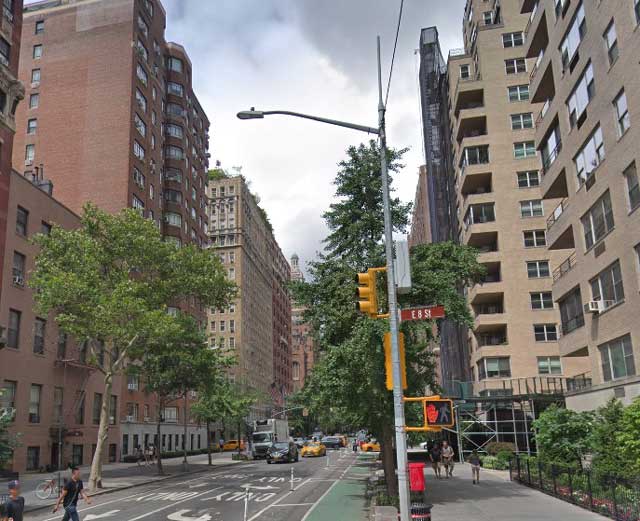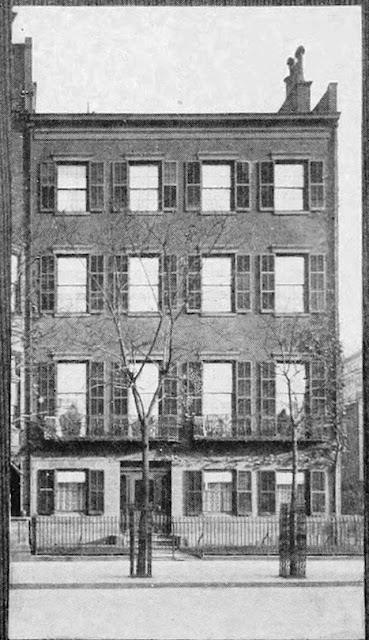Fifth Avenue at 8th Street, Manhattan
 |
| Fifth Avenue at 8th Street, NYC, in 1972. |
When you think about Washington Square - if you think about it at all, of course - you might think of classic little townhouses that line its north side, or the iconic arch, or all of the NYU buildings that surround it (including those townhouses), or maybe even the dog run. There's a lot to think about when it comes to Washington Square. However, what you probably aren't thinking about is the apartment bulding that's been looming over it since 1927. When I saw the picture above that was taken in 1972, it gave me that sense of seeing a truly classic part of New York City. While it was not taken at street view, I believe the location from which this shot is as interesting as the shot itself. So, I decided to do
a comparison of Fifth Avenue at 8th Street, Manhattan from 1972 to 2018.
 |
| Fifth Avenue at 8th Street, NYC, July 2018 (Google Street View). |
Our first step always is to verify that we are in the right location. Despite the trees, we can see that the buildings along the left (west) side of Fifth Avenue match up. These include 20 Fifth Avenue (the reddish building with the rounded edges, completed in 1940), The light brown building just beyond (24 Fifth Avenue, completed in 1926), and 40 Fifth Avenue (the building with the fancy water tower in the distance, completed in 1929). However, there's another way to verify that we are in the original location.
 |
| One Fifth Avenue, NYC, November 2017 (Google Street View). |
We can identify the exact location where the 1972 photograph was taken by looking up. The only building in the area that has the stone balconies shown in the original photograph is One Fifth Avenue, completed in 1927. Given that the photograph shows three balconies, we may assume that the photographer was standing on the fourth balcony in from the left (north) which is the double-balcony in the left-center of our 2017 photograph from Google Street View. As you can tell, only that floor has such balconies, so we know that the 1972 photograph was taken from the third floor looking north. We could probably further pin it down to an exact room number, but I think we're good just knowing the location.
 |
| One Fifth Avenue, looking from the south, a few years after its completion (Stern, Robert A.M. Gilmartin, Gregory. Mellins, Tomás. "New York 1930. Architecture and Urbanism Between the Two World Wars". New York. Rizzoli. 1987). |
So, we can see that lower Fifth Avenue below 14th Street hasn't really changed much since around the time of World War II. I've been inside 1 Fifth Avenue (so have a lot of people, it's a co-op) when I was hunting for an apartment and was intrigued by its old-world glamor. It has all those art deco pre-war touches that are so evocative of Manhattan, such as the wedding-cake exterior, all sorts of little roofs in unexpected places, and dark wood paneling here and there. It's kind of a spooky place, at least from the outside. It's also one of the most overlooked treasures in Manhattan real estate. Well, it's not
that overlooked, because it was included in the Greenwich Village Historic District established on 29 April 1969. However, it receives little attention from just about anyone from its residents and real estate agents despite its gloomy (in my opinion) magnificence.
This lower Fifth Avenue area of Manhattan was never "in decline." While other areas have gentrified, lower Fifth Avenue never needed to be. It sailed through the mean decades of the 1960s and 1970s without batting an eyelash. It retained the aura of Henry James' 1880 "Washington Square." Of course, the fact that it hasn't changed much means that some might consider some of the amenities of the apartments that haven't been completely renovated a bit... quaint. Think kitchens in the living room, that sort of thing (yes, I've actually seen that in the area). Prior to the construction of the current One Fifth Avenue, it was the site of the brownstone mansion of William Butler Duncan, which fit into James' genteel framework. Duncan's mansion and the residences at 3, 5, and 7 Fifth Avenue were all demolished to make way for the current monolithic One Fifth Avenue.
 |
| One Fifth Avenue from 8th Street, looking south in September 2017 (Google Street View). |
So, someone at 1 Fifth Avenue decided to go out on their balcony in 1972 and take a quick snap of Fifth Avenue looking north. Little could they know that the scene would be virtually unchanged almost fifty years later. Whoever it was probably couldn't even imagine the 21st Century with its flying cars, robot servants, and fancy wireless telephones. But, when Manhattan gets something right, it keeps it for a long, long time, and that's probably how long in the future the scene will stay the same, too.
I hope you enjoyed this entry in our "the more things change, the more they stay the same" series. The residential areas of New York tend to change the least, particularly when they are well-built in the first place. Please visit some of our other entries in this series!
2019






No comments:
Post a Comment
Note: Only a member of this blog may post a comment.